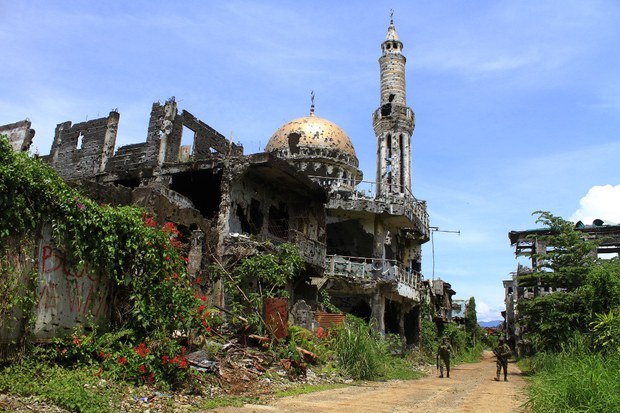Philippine Military Used Unexploded Ordnance to Clear Debris in Marawi, Group Alleges
2019.06.27
Cotabato and Iligan, Philippines
 Soldiers walk in a “no-go zone” inside central district of Marawi, two years after militants linked with Islamic State took over the southern city and battled with government forces for five months, June 20, 2019.
Soldiers walk in a “no-go zone” inside central district of Marawi, two years after militants linked with Islamic State took over the southern city and battled with government forces for five months, June 20, 2019.
A civilian advocacy group accused the Philippine military Thursday of having used unexploded ordnance to clear debris in Marawi, a southern city that was heavily damaged during urban warfare in 2017 amid a takeover by militants linked with Islamic State.
Drieza Lininding, head of the Moro Consensus Group, said he received information that clearing crews had used ordnance on at least one occasion to blast through tons of rubble that still litters large parts of downtown Marawi. He called for a probe into the alleged incident.
“Is this the standard operating procedure for demolition?” Lininding said in a statement. “We worry that those handling the debris clearing are a bunch of amateurs that lack experience in debris clearing.”
Lininding said that professional wrecking crews and those in charge of clearance of debris normally use nitroglycerine or dynamite to demolish condemned buildings or ruined structures. He said he had evidence to prove his claims.
“We want an investigation to determine if what they are doing is allowed in the country’s building code,” Lininding said.
Col. Gerry Besana, a regional spokesman for the Philippine military, denied that government contractors had used unexploded ordnance to demolish structures in Marawi. He apologized for any confusion or panic that may have resulted from the explosions.
“There was indeed defusing of bombs that happened,” Besana told BenarNews. “It’s under the law that is should be defused by authorized personnel from the army.”
“We apologize to the people for not properly relaying the information to them that later caused panic,” he said. “Rest assured, the safety of the public is our top priority.”
The siege of Marawi by pro-Islamic State (IS) militants began on May 23, 2017, and lasted for five months, posing the toughest security challenge for the Philippine government in recent memory.
The battle between the militants and government forces featured heavy aerial bombardments by the military. As many as 1,200 people, most of them militants, were killed in the fighting.
Two years later, an estimated 100,000 residents of Marawi remain displaced, and the hardest hit areas of downtown are still off limits to civilians because, the military said, many unexploded bombs still litter the city.
The fighting in Marawi forced President Rodrigo Duterte to declare martial law across the southern Mindanao region due to threats from militants. Military rule still is in force in the entire south.
On Wednesday night, the president admitted that the south remained a risky place, with militants who had escaped in Marawi known to have infiltrated other groups.
“Mindanao really seems to be a dangerous place still to go around. That is why, it could not be in terms of truth, you could not say that everything is all right there, and you go around and will not be waylaid along the way,” Duterte said.
“Mindanao remains dangerous.”
In 2018, a car bomb explosion on Basilan, an island in the south, killed 11 people, while a New Year’s Eve bombing killed two others at a shopping mall in Cotabato city. In January 2019, IS also claimed responsibility for a bombing that killed 23 people at a church on southern Jolo island during Sunday Mass.







